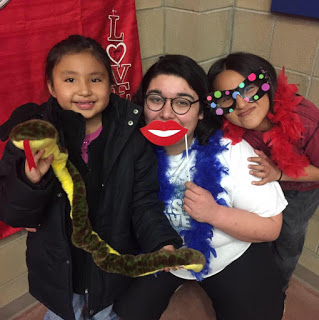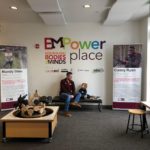AMERICORPS VISTA SCARLETT DAY-ALEMAN REFLECTS ON CONISISTENCY
Scarlett Day-Aleman is a Campus Compact AmeriCorps VISTA Member serving in Lame Deer, Montana. She shared the following piece with us recently. Thanks, Scarlett!
_________________________________________________________________
 Ten of the past twelve months of my life have been spent in service to the Northern Cheyenne Tribe in Lame Deer, Montana. I have served with two different, equally amazing, organizations. I have learned so much and made some amazing connections with the community around me. I would not trade a minute of what I am doing, or what I did in the summer, for anything in the world. Just to make it clear: I do not hold any of my organizations responsible for the pit-falls that just naturally happen, nor am I discounting the good works they are doing. However, some things need to be addressed to make sure the good intentions people have are carried out in the most positive way.
Ten of the past twelve months of my life have been spent in service to the Northern Cheyenne Tribe in Lame Deer, Montana. I have served with two different, equally amazing, organizations. I have learned so much and made some amazing connections with the community around me. I would not trade a minute of what I am doing, or what I did in the summer, for anything in the world. Just to make it clear: I do not hold any of my organizations responsible for the pit-falls that just naturally happen, nor am I discounting the good works they are doing. However, some things need to be addressed to make sure the good intentions people have are carried out in the most positive way.
The theory of “good-deed whiplash” came to me as I was evaluating the difference I was making as a VISTA and the difference I made when I was in Lame Deer during the summer. For some reason, being a VISTA makes a person extremely pensive about their purpose and contributions. This theory has been sloshing around my mind for about four and a half months and I haven’t been able to pin down an extremely formal definition, but I know the gist of what I think it means. “Good-Deed Whiplash” is the negative affects of temporary people on the lives of a community that may need semi-permanent to permanent people.
For example, the summer organization that I served with, Youth Works, arrives in Lame Deer for roughly two and a half months (80 days) and then, without much warning, picks up and leaves. The relationships formed are real and the seeds planted are great, but the feelings that kids have after are not always positive. I have talked with kids who feel almost abandoned after the summer because people that they grew to love and trust are suddenly gone. Kids are not the only people who feel the effect of “Good-Deed Whiplash”. Many community members are left to pick-up the pieces of the “good-deeds” after the people orchestrating the programs leave town.
“Good-Deed Whiplash” is most prevalent in low-income communities. Low-income communities are more likely to be grounds of broken homes where children often feel abandoned. Also, low-income communities are fertile fields for missionaries and social programs to take root. Where mission teams and social programs exist, so do temporary people eager to help.
The most prevalent example of “Good-Deed Whiplash” in my life were the conversations I had with the kids when I first moved back to Lame Deer after my summer service was over. After the initial excitement of me being back wore off one of my sixth-graders told me, “I’m so glad you came back. So many people say they’re coming back, but they never do.” Those two simple sentences really struck me. The fact that “so many” people had lied to her struck me even more. I reassured her that the friends she made over the summer still loved her and that even without them she could continue to do great things. That night I vowed to be up front with the kids and not try to pacify them by telling them shallow things. It has really made a difference in how I serve and how I talk with the kids and community I am working with.
While trying to figure out possible personal solutions for “Good-Deed Whiplash”, I have run into a few road blocks. Not everyone is afforded the opportunity to stay in the community they serve, so the solution of just telling people to stay somewhere is not a feasible one. The only feasible solution would be a two part project. The first part would be preparing the kids and the community for your departure. This could be done by making a calendar for the kids you work with so that they can see your departure date. Inform them that you have “x” amount of Friday’s left or “x” amount of days left. This would help ease them in to the transition of you leaving. Their trust would not be broken because it would not be a surprise to them. The second part would be to keep in contact with the people you work with even after you leave. Life is busy and it seems like certain things always get in the way of staying in touch, but with a little perseverance it will all fall into place. Many times, relationships formed are often forgotten when moving due to life just getting in the way. However, it is also important to realize that for some of these kids or community members their only positive influence is brought by the people coming to serve. Staying in contact does not have to be anything elaborate. All it has to be is a letter saying “Thinking of you”, a post card from your home state or where ever you end up after service. Those small gestures will go extremely far in creating sustainable changes in people that you inspire during your time in the community.
On an organizational level, “Good Deed Whiplash” could be combated with proper training. Some of the things that affect low-income communities do not affect other communities. People are not always aware of these distinctions. Optional training on abandonment issues, dealing with at-risk youth, and how poverty affects the psyche, would really alleviate issues that arise due to ignorance. Also having open discussions between former VISTAs or other service members in the community would help new VISTAs get a pulse for their community. Things like legacy binders are a great start, but should also include more things based on community relations.
While “Good Deed Whiplash” is a very real problem it is not a reason to stop serving. The things that YouthWorks does for the local community and students it brings have lasting effects on them both. The things that VISTA has done, and hopefully will continue to do, has changed the face of America for the better. Service is never a bad thing, but it can have negative effects if a proper awareness and connectivity to the intricacy of that community is not fostered. Addressing problems both on a personal level and an organizational level will help to strengthen the organization and community connection. With a few minor tweaks service organizations can continue to serve, but with a greater impact.
 Campus Compact Blog
Campus Compact Blog 
